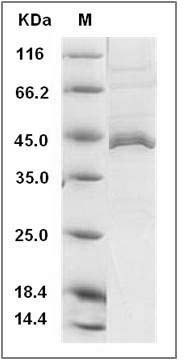-
Product Name
Human APOL1/apolipoprotein L1 (His Tag)
- Documents
-
Description
APOL1, also known as apolipoprotein L1, is a minor apoprotein component of HDL (High-density lipoprotein) or 'good cholesterol' which is synthesized in the liver and also in many other tissues, including pancreas, kidney, and brain. APOL1 belongs to the apolipoprotein L family. It may play a role in lipid exchange and transport throughout the body. It may also participate in reverse cholesterol transport from peripheral cells to the liver. Defects in APOL1 are the cause of focal segmental glomerulosclerosis type 4 (FSGS4). It is a renal pathology defined by the presence of segmental sclerosis in glomeruli and resulting in proteinuria, reduced glomerular filtration rate and edema. Renal insufficiency often progresses to end-stage renal disease, a highly morbid state requiring either dialysis therapy or kidney transplantation.
-
Protein name
APOL1 protein
-
Protein short names
APOLIPOPROTEIN L1; APOL; APO-L; RP1-68O2.2; FSGS4; APOL-I
-
Uniprot ID
Q2KHQ6
-
Gene Name
APOL1
-
Source/Expression Host
Baculovirus-Insect Cells
-
Expression Plasmid/cDNA
A DNA sequence encoding the human APOL1 (Met 1-Leu398) (Q2KHQ6) was expressed, with a C-terminal polyhistidine tag.
-
Protein Species
Human
-
Molecular weight
The secreted recombinant human APOL1 consists of 381 amino acids and predicts a molecular mass of 42.5 KDa. The apparent molecular mass of the protein is approximately 44 KDa in SDS-PAGE under reducing conditions due to glycosylation.
-
Purity
> 91 % as determined by SDS-PAGE
-
Validations

Human APOL1 / apolipoprotein L1 Protein (His Tag) SDS-PAGE
Related Products / Services
Please note: All products are "FOR RESEARCH USE ONLY AND ARE NOT INTENDED FOR DIAGNOSTIC OR THERAPEUTIC USE"
